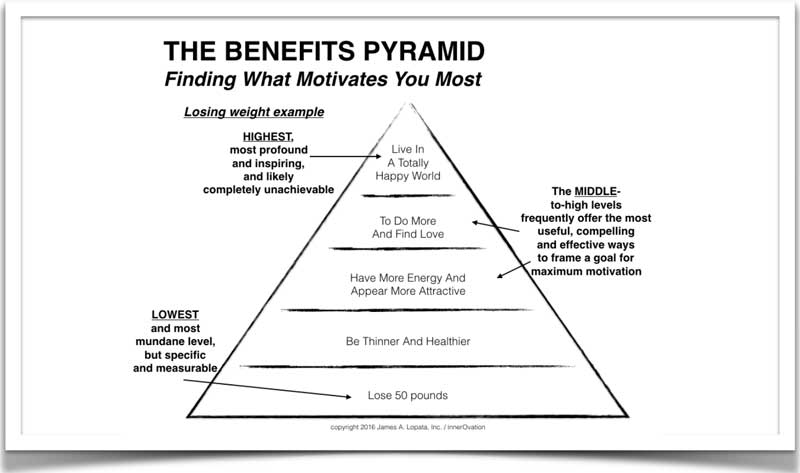Nobody really wants to lose 25 pounds.
What we really want is to be thinner.
And even that’s not what we really want.
What we really want is to feel lighter and more agile, to look and feel terrific, to have more energy to spend more fun time with the kids without feeling run down.
And it’d be great if we could get all that without losing the 25 pounds, right?
What we really truly want happiness!
P.G. Lafley, former CEO of Proctor & Gamble, knew this well. He once told his product developers stop creating a better toilet bowl cleaner and start working on a way to free up people’s Saturday mornings. Right? I mean, how motivating is a clean toilet? I’m much more interested in a fun weekend!
The question here is about finding what motivates us most!
When faced with attaining a frustrating goal, like losing weight, I frequently challenge myself and my clients to think of the most motivating way to frame it. To do that I employ what I call a benefit’s pyramid.
INTRODUCING THE BENEFITS PYRAMID
It works like this:
At the bottom is something mundane, like losing 50 pounds. At the top of the pyramid is the loftiest goal you can come up with, like living in a completely happy world. In between, from bottom to top, are increasingly abstract motivators.
Now there is a place and a time for every step from the most mundane to the loftiest. If all P&G employees did all day was think about how to free up Saturday mornings, they probably wouldn’t be making better toilet bowl cleaners, and the company would stop making products and go bankrupt and they’d be out of a job. Not much happiness there. They need to think about making toilet bowl cleaners that free up Saturday mornings. It can’t be one or the other.
So fill in the pyramid with something that’s important to you.
Here’s three steps do creating a great Benefits Pyramid:
- Write down a concrete goal you’ve been wanting to accomplish at the base of the pyramid. Perhaps: “I want to lost 50 pounds.”
- Fill in the next levels of the pyramid. An easy way to do this is to start with your goal and write “so that” statements for each level. For example, “I want to lose 50 pounds so that I can be thinner so that I can have more energy so that I can do more so that I can live happiness.
- Find the motivational factor that works for you. For me, weight loss is really about having more energy. Voila!
Here’s another example that I used for helping me create these blog posts. I want to create these blog posts so that I can share some important things with the world so that I can help people live better so that people are happier so thatthere can be a really happy world.
The most motivating thing for me is how these posts can help people live better. So I keep that front and center.
For instance, today I really didn’t feel like creating a post. So I tell myself that by doing so I’m helping people live better and happier and then my world will be happier. It gets me off my butt. It’s better than telling myself to just get up and make a post. Although that is sometimes motivating too.
And, voila! Here’s your post!
How do you motivate yourself to do things you’d rather not do?
I’m always looking for inspiration.
Happy Motivational Monday!

